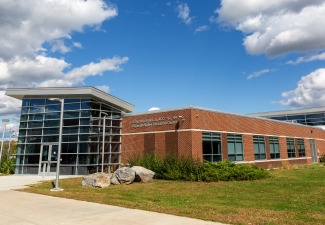SUNY Plattsburgh Students Earn Honors for DNA Research
Three students recently received top awards in scientific research competitions for work done with frogs and ancient skeletons under the guidance of Dr. Nancy Elwess and Sandra Latourelle in SUNY Plattsburgh’s Department of Biology.
Michael Haynes, a junior biology major from Brooklyn, N.Y., placed second in the ecology and evolutionary biology division of the international Sigma Xi Research Society’s Student Research Showcase, held online in March.
Meanwhile, Justin Andrews and MacKenzie Kilkeary ’12 garnered first- and second-place honors, respectively, in the Society of College Science Teachers’ poster contest in San Antonio, Texas, in April.
Extracting DNA from Skeleton Teeth
For his project, Haynes worked with Edmund Adjapong, a 2012 graduate from the Bronx,
N.Y., to extract DNA from the teeth of 25 skeletons, randomly selected from SUNY Plattsburgh’s
ancient skeleton collection. That collection, the largest of its kind in the world,
includes about 580 Maya skeletons, excavated over the years by SUNY Distinguished
Professor of Anthropology Dr. Mark Cohen.
According to Haynes, those DNA extractions contribute to current knowledge about the
ancient Maya and can help give insight into the migration routes into the New World
as scientists compare the samples to those from other
indigenous groups.
Andrews, a junior earth and environmental science major from Warrensburg, N.Y., started working on a DNA database of the Lake Champlain basin frog population in the summer of 2011.
Andrews hopes the data he has collected will provide a starting point for other research.
“What other scientists can do is take the DNA that I’ve collected from the frogs here and compare it to the genes of different frogs all over the world,” Andrews said.
Elwess agreed, noting that it will enable scientists here and elsewhere to determine evolutionary pathways and compare DNA through phylogenetic trees, diagrams that depict the lines of descent for the species.
Determining Sex from Old Bones
Meanwhile, for his project, Kilkeary worked to determine the sex of juvenile ancient Maya skeletons.
“He needed to figure out a way using DNA,” Elwess said.
She noted that while this sounds simple, it was not. In most DNA samples, a scientist would just have to look for XX or XY chromosomes. In this case, however, the ancient DNA had broken into tiny fragments over time.
“So, MacKenzie was testing for the presence of small pieces of DNA (genetic markers) that would only be found on an X or Y chromosome to determine the sex,” Elwess said. “This is very difficult to do, given the fragile state and small sizes of the DNA.”
A Plattsburgh native, Kilkeary graduated in December with a bachelor’s degree. He believes his research and hands-on experience at SUNY Plattsburgh helped gain him entrance into the forensic science graduate program at Marshall University in West Virginia.
“The fact that we can even do undergraduate research is awesome because a lot of schools don’t offer that,” he said. “I think my undergraduate research is what really stood out in my application.”
The Importance of Ownership
Elwess and Latourelle monitor their students’ work and make sure the research topics speak to each student’s interests.
“If they have ownership over the project, it’s more meaningful,” Elwess said.
As the research evolves, the two step back to let the students become more independent.
“They’re doing something by themselves for themselves,” Latourelle said. “It’s very worthwhile.”
And, according to Elwess, the judges thought it was worthwhile, too.
“The awards were given based on the level of the work the students were doing — some of the judges thought the students were graduate students — and the importance of the work to their selective field,” Elwess said.
News

SUNY Adirondack Students Benefit from New Dual Agreement with SUNY Plattsburgh Queensbury
